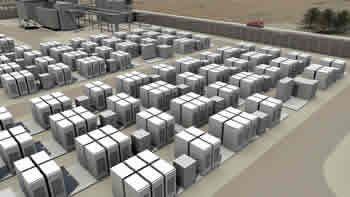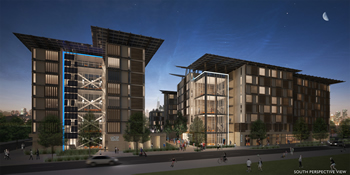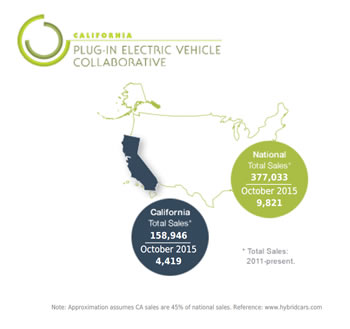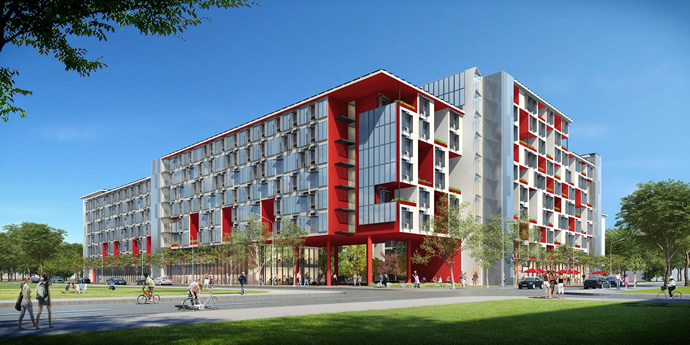Californians and their governments are always pushing the envelope when it comes to the environment. Sometimes that pushes business away. And sometimes it pulls everyone together in novel ways.
A cascade of energy news in October illustrates some of these pioneering developments.
Hybrid-Electric Buildings
The Irvine Co., based in Newport Beach and San Francisco, announced its plan to become the world’s first major real estate company to create a fleet of hybrid-electric buildings powered by state-of-the-art energy storage systems from Tesla Energy, after signing an MOU with San Francisco-based Advanced Microgrid Solutions (AMS).
“Large battery systems at each building in the company’s coastal California portfolio will be charged during nonpeak hours and be used, when needed, for peak daytime use or in the event of a power failure,” said the company. Stored energy initiatives such as this one are part of Southern California Edison’s (SCE’s) grid modernization plan. The first phase of the project, involving up to 24 office buildings in Irvine, is expected to reduce peak demand in those buildings by 25 percent and provide SCE with up to 10 megawatts of reserve capacity, enough to supply power to 10,000 homes. The first energy storage units in Irvine are expected to be installed by the end of this year.
“As a long-term owner, the Irvine Company takes great pride in being on the cutting edge of building design, sustainability and energy efficiency,” said Rich Bluth, Irvine Company’s vice president of Energy Management. “Energy storage is a game-changer. It will allow building owners to participate in grid support and reduce costs while causing no disruption or discomfort to our customers, residents or guests.”

For the initial part of the Irvine Company project, AMS will team with renewable energy giant SunEdison to finance, install and operate Tesla Powerpack commercial battery system,s including seamlessly switching the buildings to battery power whenever SCE signals that demand on the grid is too high. AMS and SunEdison signed an agreement in July to finance and deliver 50 MW of energy storage for SCE under long-term capacity contracts. Once operational, the AMS projects are expected to be the first storage assets to be acquired by Terraform Power, Inc., a global owner and operator of clean energy power plants.
According to the agreement, the storage system contracts were awarded to AMS as part of SCE’s 2013 Local Capacity Requirement solicitation, and will be built on commercial and industrial customer sites throughout the West Los Angeles Basin. “SCE will purchase capacity from the storage systems under a 10-year capacity contract, and expects to use the electricity stored in these fleets of hybrid-electric buildings in part to offset the power once produced by the decommissioned San Onofre nuclear power plant and other soon-to-be retired gas-fired plants,” the companies said in July. “This program is part of SCE’s plan to modernize the grid by adding 2.2 gigawatts of newer, cleaner resources including energy storage and renewables by 2022.”
“This initiative creates value all the way around—for building owners, customers and utilities,” said Susan Kennedy, CEO of AMS and former chief of staff to Gov. Arnold Schwarzenegger, of the Irvine Co.’s plan. “SCE is tapping into the power of their own customers’ building load to manage the grid. This revolutionary partnership between a utility and its customers represents the future of the electric grid.”
Net-Zero Buildings
About 10 days after the Irvine announcement, Pacific Gas and Electric Company (PG&E) and the American Institute of Architects, California Council (AIACC) announced the winners of the fifth annual Architecture at Zero competition for zero net energy (ZNE) building design, awarding the six student and professional winners with a total of $25,000 in prizes. ZNE structures produce as much energy as they use during a year, through a combination of energy efficiency and on-site renewable energy generation.
Contestants designed a hypothetical ZNE building on University of California, San Francisco’s (UCSF) Mission Bay campus — a neighborhood seeing more than its share of recent life sciences and mixed-use investment. Winners were chosen from more than 30 entries that designed plans for multi-family housing.

“The Architecture at Zero competition demonstrates how we can push the boundaries of reducing energy waste through innovative, efficiently designed buildings. Supporting zero net energy designs is one of the many ways PG&E can lead on its commitment to help support California’s ambitious energy efficiency goals – laid out in Senate Bill 350 and Assembly Bill 802,” said Vincent Davis, senior director of Energy Efficiency at PG&E, referring to recent progressive legislation signed by Gov. Jerry Brown.
“While the designs are not intended for actual construction by the university, the competition will generate new, innovative ideas for ZNE construction to help achieve the California Public Utilities Commission’s goals for all new residential construction in California to be ZNE by 2020 and all new commercial construction to be ZNE by 2030,” said a release from PG&E and AIACC.
Plug-In EVs
On Oct. 15, Gov. Brown and more than 40 California corporate leaders, public sector partners and industry leaders met at an event they called “Drive the Dream 2015” to announce new commitments and initiatives aimed at accelerating the continued adoption of plug-in electric vehicles (PEVs) and workplace charging. Among the state’s aggressive goals is a plan to create a charging network to handle 1 million electric vehicles by 2020.
“Workplace charging is a key component to encouraging more drivers to choose electric vehicles,” said Janea A. Scott, commissioner for the California Energy Commission and chairman of the Plug-In Electric Vehicle Collaborative. “The significant commitment and investment employers made today, and that we hope additional employers will make, to bring electric vehicle charging to California workplaces can help accelerate the transition to zero emission vehicles.”
Among the corporate highlights:

- Honda announced it is adding 120 new electric vehicle chargers on its Torrance headquarters campus. To support the local community in conjunction with the project, Honda is installing a publicly accessible DC Fast Charger on Harpers Way, adjacent to its campus.
- San Diego Gas and Electric (SDG&E) announced it will add more than 150 EV work vehicles to its fleet, including trouble trucks and aerial lifts. Since 2013, SDG&E has grown its workplace charging stations by 500 percent — from 26 to 158 in 2015. In addition, the utility has offered three shareholder-funded employee incentive programs that have grown their employee EV ownership by 300 percent — from 45 to more than 180. Through its new “Race to 500” program the utility hopes to get 500 employees driving EVs by 2020.
- NBCUniversal announced it has invested in 64 charging spaces across its property in support of employees and guests who drive EVs.
- PG&E announced it will invest $35 million for new chargers, workplace incentives, and expand its corporate PEV fleet. This includes adding 152 new PEVs to the utility fleet, continuing to provide employee incentives of $2,000 to purchase PEVs and installation of another 180 new employee charging stations throughout the state, bringing the total to 400. To date more than 700 employees have used $1.2 million in employee incentives to purchase PEVs.
- The Coca-Cola Co. announced a doubling of its 2013 commitment in California, adding charging stations at seven Coca-Cola facilities in California. Coca-Cola is deploying 28 hybrid-electric service vans in California, marking the largest commercial hybrid retrofit program ever in the state. Through a partnership with XL Hybrids, Coca-Cola has converted more than 280 of its service vans into fuel-efficient hybrid-electric vehicles across the U.S.
- Ford Motor Co. has begun installing charging stations in California and currently has 145 units available for employee use at 43 Ford offices and manufacturing facilities in six states and Canada. There are plans to install 20 more in the near future, with ongoing discussions to increase the number in the long term.
- Southern California Edison announced that over the next 12 months it is installing an additional 50 level 1 and 2 fleet charging stations to supplement its existing 340 charging stations that support its current fleet vehicles and future fleet acquisitions; it will acquire an additional 36 Plug-in EV (PEV) fleet vehicles, an approximate $4.5-million investment; it is installing an additional 25 level 1 and 2 workplace charging stations at Edison facilities to supplement its existing 100 stations in operation today, an approximately $250,000 investment. SCE will continue its support of the Edison Electric Institute (EEI) industry-wide pledge that calls for the company to commit at least 5 percent of its annual fleet acquisition budget to PEV purchases.
- NRG announced that it has doubled its network in size in the last eight months from nearly 250 sites to more than 500 around the country. The company is committing its most ambitious network build-out in California, offering more payment options and charges for more vehicles than any other network in the country.
- CBRE announced it has partnered with an EV charging company in an education campaign to bring greater awareness of electric vehicle benefits to its commercial property professionals in 12 cities across the nation. “CBRE recognizes that commercial buildings are the new ‘gas’ stations for its tenants who own electric vehicles,” said the company, which is focusing on being a catalyst for the EV industry at its more than 50 California office buildings of greater than 250,000 sq. ft.
- Vision Fleet announced a goal to work with corporate, government, and other innovative fleets in California to deploy 2,000 PEVs in the state by the end of 2016.

